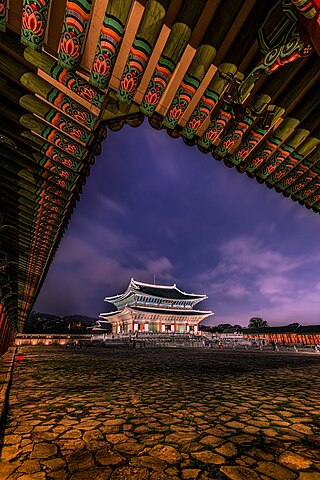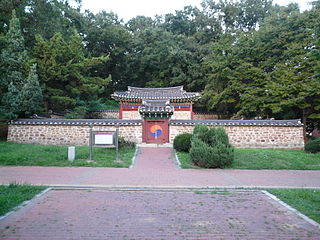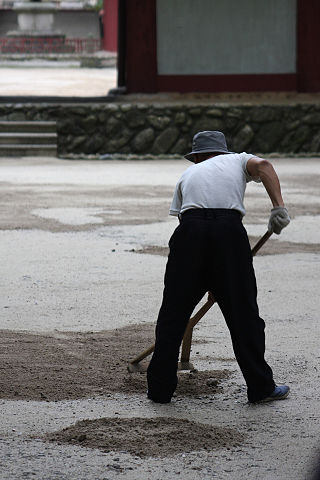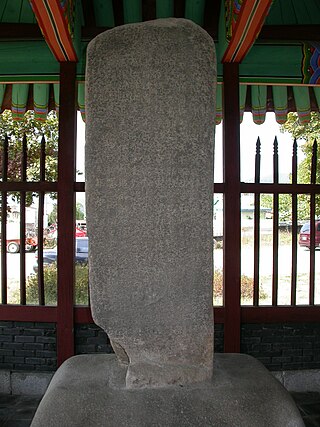
Yeongju is a city in the far north region of North Gyeongsang province in South Korea, covering 668.84 km2 with a population of 113,930 people according to the 2008 census. The city borders Bonghwa county to the east, Danyang county of North Chungcheong province to the west, Andong city and Yecheon county to the south, and Yeongwol county of Gangwon province to the north.

Jecheon is a city in North Chungcheong Province, South Korea. The city is a major railway junction or a transportation mecca, served by the Jungang, Chungbuk and Taebaek Lines. Jecheon has scenic surroundings and several tourist spots like the Uirimji Reservoir, Cheongpung Lake and Cheongpung Cultural Properties complex. It is also the home of Semyung University.

A National Treasure is a tangible treasure, artifact, site, or building which is recognized by the South Korean government as having exceptional artistic, cultural and historical value to the country. The title is one of the eight State-designated heritage classifications assigned by the administrator of the Cultural Heritage Administration (CHA) in accordance with the Cultural Heritage Protection Act after deliberation by the Cultural Heritage Committee.

Korean architecture refers to an architectural style that developed over centuries in Korea. Throughout the history of Korea, various kingdoms and royal dynasties have developed a unique style of architecture with influences from Buddhism and Korean Confucianism.

Sudeoksa is a head temple of the Jogye Order of Korean Buddhism. It is located on the southern slopes of Deoksungsan in Deoksan-myeon, Yesan County, South Chungcheong Province, South Korea.

Beopjusa, is a head temple of the Jogye Order of Korean Buddhism. It is situated on the slopes of Songnisan, within Songnisan National Park, in Naesongni-myeon, Boeun County, in the province of Chungcheongbuk-do, South Korea.

Woljeongsa is a head temple of the Jogye Order of Korean Buddhism, located on the eastern slopes of Odaesan in Pyeongchang County, Gangwon Province, South Korea. Woljeongsa was founded in 643 by the Silla monk Jajang.

Yongjoosa is a head temple of the Jogye Order of Korean Buddhism. It is located in on the slopes of Hwasan in Taean-eup, Hwaseong, in the province of Gyeonggi, South Korea. The temple's name means "dragon jewel temple."

Yangdong Folk Village is a traditional yangban village from the Joseon dynasty. The village is located in Gangdong-myeon, sixteen kilometers northeast of Gyeongju, Gyeongsangbuk-do, South Korea, along the Hyeongsan River. Mt. Seolchang stands to the north of the village. The village is designated as Important Folklore Materials No. 189 by the South Korean government.

The Yeongnamnu or Yeongnamru is a pavilion on a cliff overlooking the curve of the Miryang River in central Miryang, Gyeongsangnam-do, South Korea. It dates to the Joseon Dynasty and is one of the central cultural treasures of Miryang. The current structure was built in 1884 according to the design of then-magistrate Yi In-jae. During the Joseon period, this was known as one of the three great pavilions of Korea, together with the Chokseongnu in Jinju and the Pubyŏk pavilion in Pyongyang.

Sinwonsa is a Buddhist temple in the South Chungcheong province in South Korea. Sinwonsa is located in Yanghwari Gyeryong-myeon Gongju, and one of three main temples in Gyeryong mountain along with Donghaksa and Gapsa. The temple was built by the monk Bodeokhwasang in the 11th year (651) of King Uija's reign of Baekje, and underwent several expansions. Gaeyeonhwasang is said to have renovated the current daeungjeon in 1876.

Myogaksa Temple is a Korean Buddhist temple located in the heart of downtown Seoul, South Korea, in the Jongro District, nestled on the east side of Naksan Mountain. It houses the administrative headquarters of the Gwaneum Order of Korean Buddhism. It is located close to the Dongmangbong Peak, Naksan Park, Donggwanmyo Shrine and Dongdaemun Market.

Seonam Temple, or Seonamsa, is a Korean Buddhist temple on the eastern slope at the west end of Jogyesan Provincial Park, within the northern Seungjumyeon District of the city of Suncheon, South Jeolla Province, South Korea. It belongs to the Taego Order although the Jogye Order claims possession over it.
Tonggun Pavilion is the hall located in Uiju county, North Pyongan Province of North Korea. The pavilion faces Liaoning Province, China right forward. The formation of the building seems like square.

Seven-story Stone Pagoda in Tappyeong-ri, Chungju, also called the Jungang Pagoda, is a 14.5 meter tall stone pagoda near the Namhan River in North Chungcheong Province, South Korea. It is the tallest stone pagoda of the Later Silla period.

Sasechungyeolmun, lit. Shrine of Loyalty, Virtue and Filial Duty, Sasechungyeolmun are a historic pair of two wooden gates dedicated to Kim Yeomul (1548–1592), and the four generations of female members of his family who had committed suicide.

The Anak Woljongsa is an historic Buddhist temple, one of the National Treasures of North Korea (#75). It is located in Woljong-ni, Anak County, South Hwanghae Province. It is located near Mt. Kuwol.

The Chido Museum is a private museum in Tsuruoka, Yamagata Prefecture, Japan.

The Jungwon Goguryeo Monument is a stele in Chungju, North Chungcheong Province, South Korea, dating from the late 5th century. It is the only stele of the state of Goguryeo found on the Korean peninsula.
































